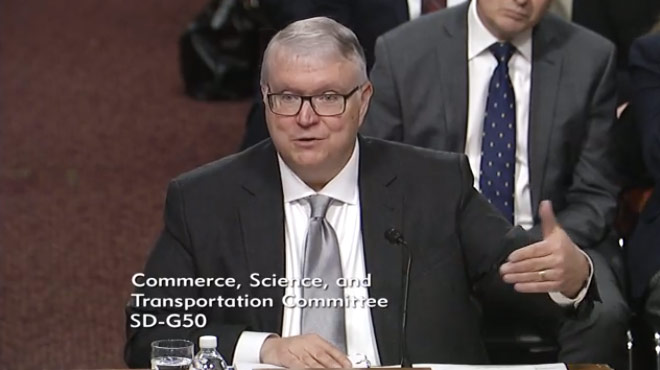O’Connell: Debris Top Priority in New Space Safety Rules
Posted on

Kevin O’Connell, head of the Office of Space Commerce.
WASHINGTON: “The space environment represents an unbelievable amount of economic potential, but that potential will only be realized if we take measures now to ensure the preservation of its long-term viability and sustainability,” says Kevin O’Connell, the head of the Commerce Department’s Office of Space Commerce. Commerce is in stage two of its review of current space safety rules that may result in new requirements for debris mitigation and space situational awareness (SSA) best practices.he told Secure World Foundation’s ‘Summit for Space Sustainability’ yesterday.
In a larger sense, “space debris is in some sense an economic problem … especially as space commerce grows,” he noted.
O’Connell said his office is now summarizing comments on the Commerce Department’s April Request for Information (RFI) about commercial SSA capabilities, best on-orbit practices to avoid collisions, and potential new SSA and space traffic management rules. The majority of respondents, he noted, agree that there is a need for better data sharing about the locations of debris and satellites.
“The majority of these inputs agree that enhanced, standardized data sharing is the key to tracking more objects to prevent [potential on-orbit collisions] and assist in debris mitigation,”
The next step in the rule-making process, he said, will be an industry day in coming weeks to discuss Commerce’s reactions as it develops a new US framework for STM.
Commerce received over 42 responses to its April 11 RFI on three baskets of issues related to future US regulation of commercial space activities, including those that may have military and/or intelligence applications:
- Commercial Enhanced SSA/STM Capabilities
- STM, SSA and Orbital Debris Mitigation Best Practices
- Appropriate SSA/STM-Related Regulations To Spur U.S. Space Commerce
Of the three baskets, the most immediate questions surround debris mitigation practices, and the need to improve SSA capabilities. O’Connell said that the comments came from established space companies, satellite operators, analytics providers and even cloud computing companies, in addition to academia and civil society organizations.
“In my own personal read of the RFI responses, we’re seeing some very, very interesting responses — mostly not from the space community — that speak to this issue as another high-end data analytics problem,” he added. While the space environment has some unique characteristics, he said there is as much effort to needed to solve the analytic problems of managing SSA data and predicting future orbits of objects in space, as on the problem of how to obtain new sensor data to expand tracking of satellites and space debris. The key, he explained, being able to standardize data.
“We’re also putting the in the final documents between ourselves and the Air Force Research Lab to gain access to the Unified Data Library,” O’Connell added. “Maj. Gen. Kim Crider and I spoke just yesterday about some of the very final details and getting them on paper. So, we should be able to get access to that tool very, very soon — as the very first step in what we call the Open Architecture Data Repository.”
Air Force leaders (including acquisition chief Will Roper) hope that the Unified Data Library (UDL) will be able one day to mesh data from all types of sensors to provide SSA information and command and control (C2) for most Air Force military missions. It is also being used to incorporate data coming from commercial providers, and eventually will be expanded to include SSA data from allies. As I reported in May, Commerce is keen to test the UDL as one tool in its future mission of providing warnings to operators of potential collisions via the Open Architecture Data Repository — the civil equivalent to the military’s catalog of space objects — that can be easily updated and expanded.
O’Connell explained that the economic value of space is one of the reasons that the Trump Administration, under Space Policy Directive-3 (SPD-3) designated Commerce as the civil agency for warning civil operators about close approaches of spacecraft and/or debris that might lead to collisions (known in SSA circles as ‘conjunction assessments’.) SPD-3 (issued in June 2018) on National Space Traffic Management Policy mandates that Commerce take over civil/commercial SSA responsibilities from the Air Force’s 18th Space Control Squadron, and regulate new types of space activities such as satellite servicing. It also gives Commerce authority to review US orbital debris mitigation practices followed by all space operators. Under the plan, O’Connell’s office also would be elevated out from under its current management at the National Oceanic and Atmospheric Agency (NOAA) to a separate Bureau directly under Commerce Secretary Wilbur Ross.
That shift in authorities requires congressional approval that up to now has been somewhat in doubt. Commerce got some good news on the plan late last week, when the House Appropriations Committee adopted an amendment to its fiscal year 2020 funding bill for NASA and NOAA that reversed its earlier opposition to the reorganization. The amendment, sponsored by Rep. Brian Babin, would move NOAA funds in a manner that would allow Ross to reprogram them to initiate the new Bureau. The House appropriators yesterday passed the Commerce-Science-Justice bill as part of the so-called ‘Minibus’ appropriations package that includes funding for a number of other civil agencies as well as military construction.
Subscribe to our newsletter
Promotions, new products and sales. Directly to your inbox.
